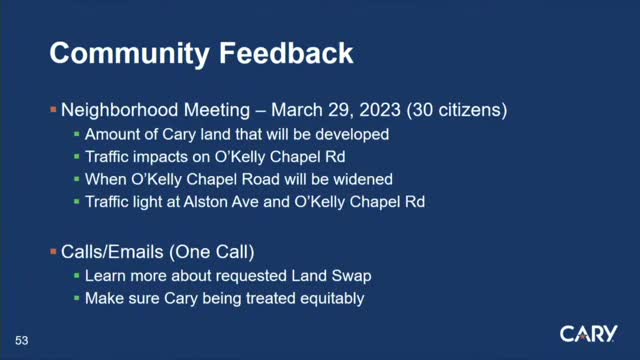Citizens demand traffic improvements amid development concerns
August 27, 2024 | Cary Town, Wake County, North Carolina
This article was created by AI summarizing key points discussed. AI makes mistakes, so for full details and context, please refer to the video of the full meeting. Please report any errors so we can fix them. Report an error »

A recent neighborhood meeting drew approximately 30 residents who voiced concerns regarding the development of carried land and its impact on O'Kelly Chapel Road. Key issues raised included anticipated traffic congestion, the timeline for road widening, and the potential installation of a traffic signal at the intersection of Alston Avenue and O'Kelly Chapel.
Despite the lack of communication from residents prior to the council public hearing, one citizen reached out for clarification on a proposed land swap, expressing concerns about ensuring that the carried land was not being exploited. During the public hearing, another resident supported the development for its potential to enhance shopping options and services for local employers, particularly those in the Research Triangle Park (RTP). However, this speaker echoed concerns about traffic conditions and urged for improvements to the O'Kelly Chapel Road corridor if the proposal moves forward.
In response to feedback from the public hearing, the applicant made several modifications to the proposal. The commitment to affordable housing was extended from 15 to 30 years, and the minimum streetscape width along NC 55 and O'Kelly Chapel Road was increased from 10 to 20 feet. Additionally, the maximum building height for three of the development pods was reduced from 15 to 10 stories, and new criteria were established for the location and screening of dumpsters.
The applicant also revised their electric vehicle (EV) charging commitment, shifting from a fixed number of 40 charging ports to a ratio-based system linked to the number of units and the extent of development. This change means that the number of charging ports could range from 39 in a minimum scenario to 83 in a maximum scenario, depending on the final development scale.
As the proposal progresses, the council will continue to consider community feedback and the implications of the development on local infrastructure and services.
Despite the lack of communication from residents prior to the council public hearing, one citizen reached out for clarification on a proposed land swap, expressing concerns about ensuring that the carried land was not being exploited. During the public hearing, another resident supported the development for its potential to enhance shopping options and services for local employers, particularly those in the Research Triangle Park (RTP). However, this speaker echoed concerns about traffic conditions and urged for improvements to the O'Kelly Chapel Road corridor if the proposal moves forward.
In response to feedback from the public hearing, the applicant made several modifications to the proposal. The commitment to affordable housing was extended from 15 to 30 years, and the minimum streetscape width along NC 55 and O'Kelly Chapel Road was increased from 10 to 20 feet. Additionally, the maximum building height for three of the development pods was reduced from 15 to 10 stories, and new criteria were established for the location and screening of dumpsters.
The applicant also revised their electric vehicle (EV) charging commitment, shifting from a fixed number of 40 charging ports to a ratio-based system linked to the number of units and the extent of development. This change means that the number of charging ports could range from 39 in a minimum scenario to 83 in a maximum scenario, depending on the final development scale.
As the proposal progresses, the council will continue to consider community feedback and the implications of the development on local infrastructure and services.
View full meeting
This article is based on a recent meeting—watch the full video and explore the complete transcript for deeper insights into the discussion.
View full meeting
